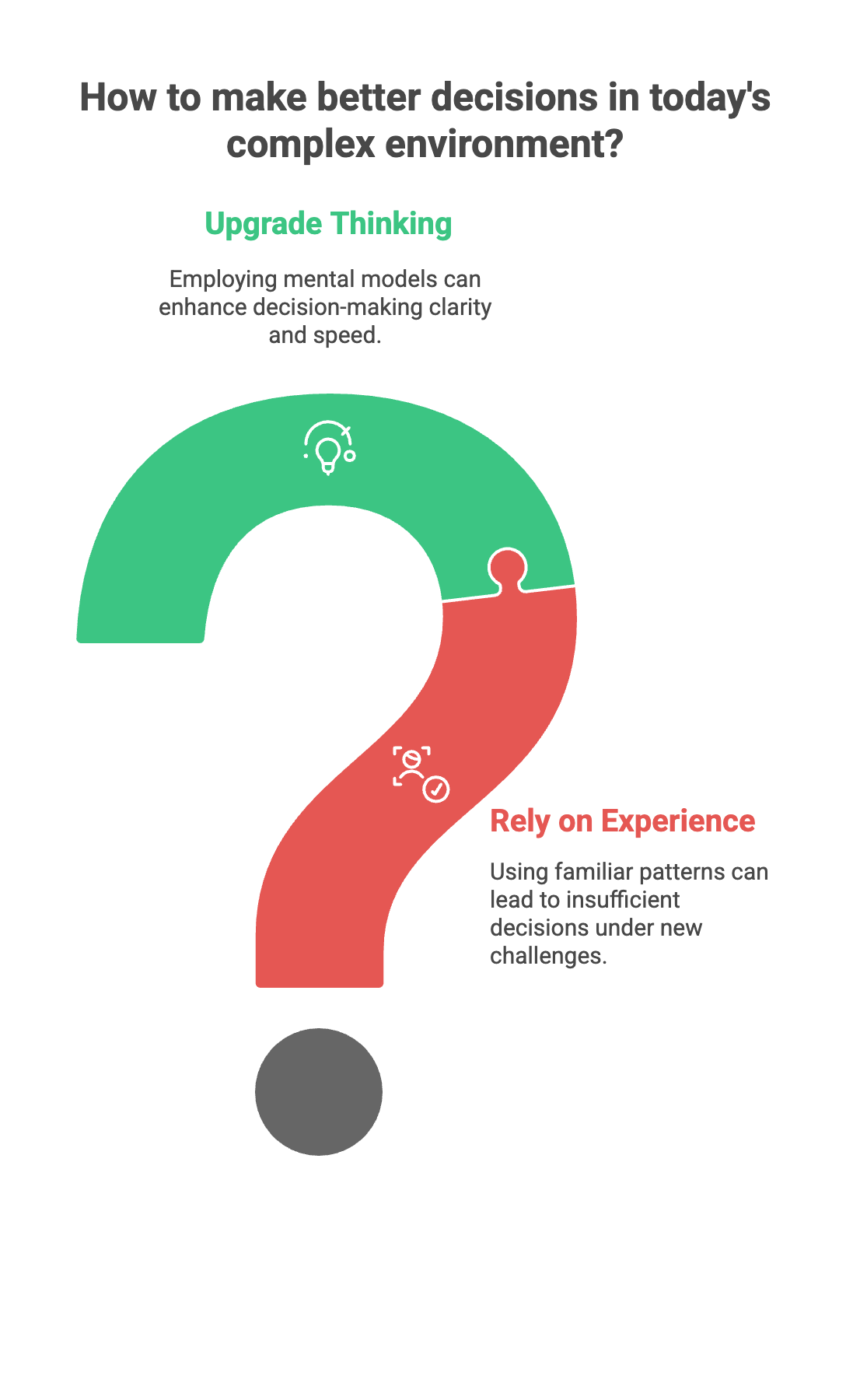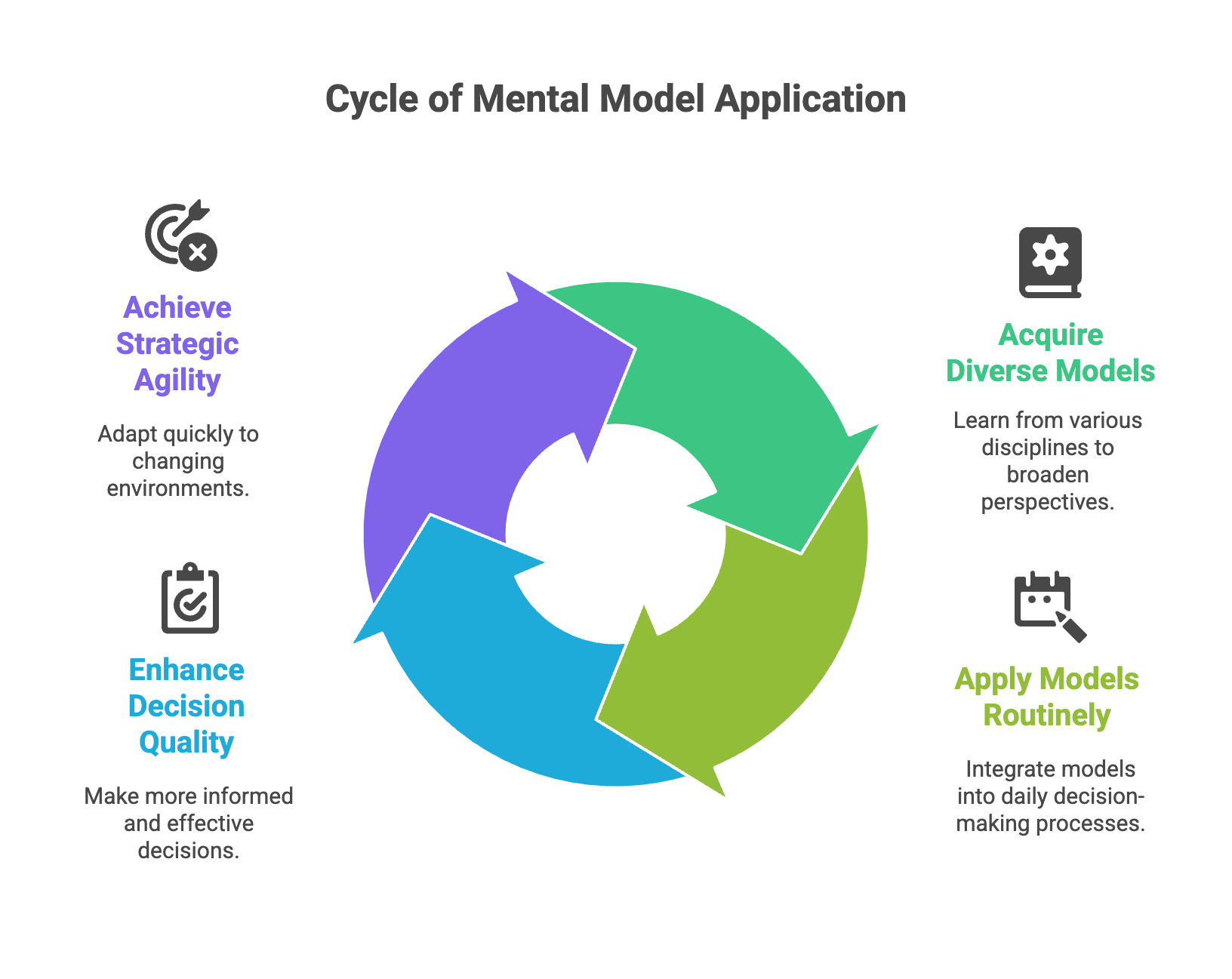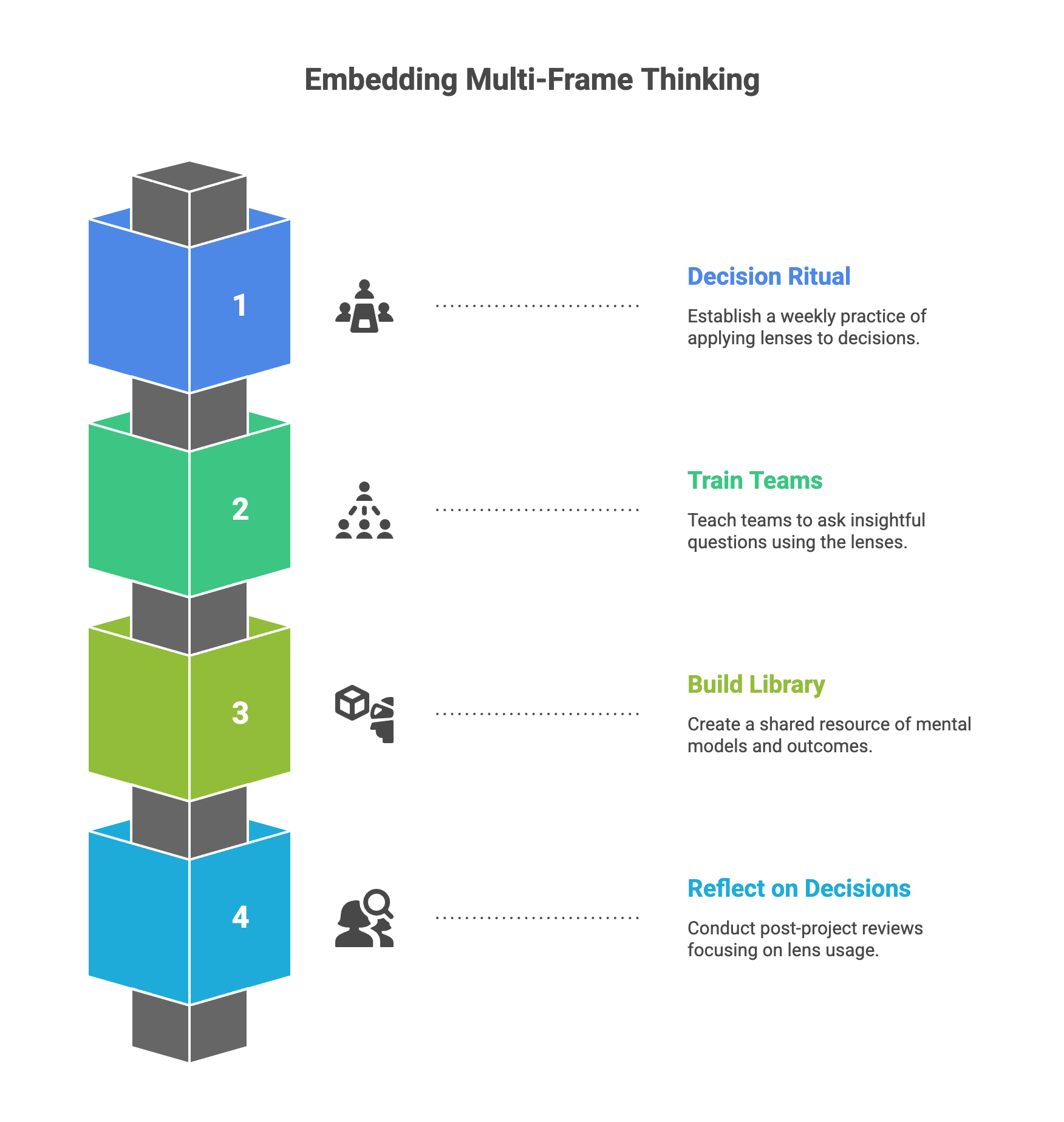Mental Model
July 23, 2025
5
Min
Mental Models for Better Decision-Making: A Practical Framework
Decision Making
|
Most leaders think they are. After all, we’ve spent decades honing our judgment under pressure, sharpening our instincts through experience, and learning from the occasional misstep. But here’s the rub: experience can trap us as much as it can teach us. The more we succeed using familiar patterns, the more we default to them - especially under stress.
This matters because today’s challenges don’t look like yesterday’s. The stakes are higher, the inputs noisier, and the time to decide shorter. Relying on gut instinct or linear thinking isn’t just risky - it’s often insufficient.
What if we told you that your thinking itself could be upgraded?
In this post, we explore how seasoned decision-makers can use mental models not as academic curiosities but as practical scaffolding for clearer, faster, and wiser decisions.

A mental model is simply how we explain how something works. Think of it as a lens. The sharper and more varied your lenses, the more angles you can see - and the less likely you are to miss the hidden trap or the breakthrough insight.
Charlie Munger, vice chairman of Berkshire Hathaway, put it best:
"You must know the big ideas in the big disciplines and use them routinely - all of them, not just a few."
This approach isn’t about complexity. It’s about completeness. When leaders draw from a latticework of models - from psychology to physics to systems theory - they gain an edge in environments where clarity is scarce.
McKinsey research supports this: leaders who consistently apply multiple mental models report higher-quality decisions and greater strategic agility. Yet very few embed this thinking into their leadership routines.

We’ve refined a framework that helps leaders bring mental models into everyday use. We call it The 4-Lens Decision Model. It brings just enough rigour to stretch your thinking - without paralysing it.
Strip the problem down to its core truths. What are we assuming that may not be true? What would this look like if we were solving it for the first time, from scratch?
This is particularly useful when you’re facing:
🟡 Reflection prompt: Where am I borrowing an old answer for a new problem?
Micro-action: Run a 30-minute First Principles Jam with your team. Pose one assumption and ask: “Why must this be true?” three times in a row.
What happens next... and after that? Don’t just look at the immediate result - consider the ripples.
Use this when:
🟡 Reflection prompt: What consequence am I underestimating because it’s delayed or indirect?
Micro-action: Plot out a decision tree with second- and third-order effects. Invite someone from another function to challenge your projections.
Instead of asking how to succeed, ask: “How could we fail?” This forces you to confront blind spots and preventable errors.
Highly effective for:
🟡 Reflection prompt: If we look back in a year and this failed, what will have caused it?
Micro-action: Add a “pre-mortem” section to your next planning meeting. Spend 15 minutes imagining what went wrong.
View the problem not as a moment but as a motion - part of a larger dynamic. What feedback loops are in play? Where might the system push back?
Apply this when:
🟡 Reflection prompt: Are we treating symptoms while the system maintains the cause?
Micro-action: Create a basic causal loop diagram. Map 3-4 key variables and how they influence each other over time.

Create a Decision Ritual
Pick one lens per week and apply it to an active issue. Build a habit of multi-frame thinking over 30 days.
Train Your Teams to Ask Better Questions
Model this thinking openly. In meetings, say: “Let’s flip this using inversion” or “What’s the system likely to do in response?” Language cues trigger new pathways.
Build a Mental Model Library
Keep a shared Notion page or internal wiki. Whenever someone uses a model, log the scenario and outcome. Over time, this becomes a learning asset.
🔹 Pro Tip: Tie reflection sessions to real decision cycles. Post-project reviews shouldn’t just ask “what happened?” - they should probe which lens was (or wasn’t) used.

Even seasoned leaders misuse mental models. Here are four missteps we often encounter:
Prompt 1: When was the last time I challenged an assumption I’ve relied on for years? What lens might have helped me earlier?
Prompt 2: Choose one high-stakes decision from the past quarter. Re-run it through all four lenses. What would I change?
Here’s what we’ve seen in organisations that embed model-based thinking:
And perhaps most valuably, a culture where decision-making becomes a craft, not just a scramble.
This isn’t about being smarter. It’s about thinking differently - and more deliberately - when it counts.
Pick a decision that’s coming up - strategic, personal, or operational. Run it through at least two of the four lenses. Note what shifts.
Then come back and tell us: what surprised you? What was clearer? What still felt fuzzy?
Let’s build a smarter culture of leadership - one lens at a time.
Team SHIFT
Most leaders think they are. After all, we’ve spent decades honing our judgment under pressure, sharpening our instincts through experience, and learning from the occasional misstep. But here’s the rub: experience can trap us as much as it can teach us. The more we succeed using familiar patterns, the more we default to them - especially under stress.
This matters because today’s challenges don’t look like yesterday’s. The stakes are higher, the inputs noisier, and the time to decide shorter. Relying on gut instinct or linear thinking isn’t just risky - it’s often insufficient.
What if we told you that your thinking itself could be upgraded?
In this post, we explore how seasoned decision-makers can use mental models not as academic curiosities but as practical scaffolding for clearer, faster, and wiser decisions.

A mental model is simply how we explain how something works. Think of it as a lens. The sharper and more varied your lenses, the more angles you can see - and the less likely you are to miss the hidden trap or the breakthrough insight.
Charlie Munger, vice chairman of Berkshire Hathaway, put it best:
"You must know the big ideas in the big disciplines and use them routinely - all of them, not just a few."
This approach isn’t about complexity. It’s about completeness. When leaders draw from a latticework of models - from psychology to physics to systems theory - they gain an edge in environments where clarity is scarce.
McKinsey research supports this: leaders who consistently apply multiple mental models report higher-quality decisions and greater strategic agility. Yet very few embed this thinking into their leadership routines.

We’ve refined a framework that helps leaders bring mental models into everyday use. We call it The 4-Lens Decision Model. It brings just enough rigour to stretch your thinking - without paralysing it.
Strip the problem down to its core truths. What are we assuming that may not be true? What would this look like if we were solving it for the first time, from scratch?
This is particularly useful when you’re facing:
🟡 Reflection prompt: Where am I borrowing an old answer for a new problem?
Micro-action: Run a 30-minute First Principles Jam with your team. Pose one assumption and ask: “Why must this be true?” three times in a row.
What happens next... and after that? Don’t just look at the immediate result - consider the ripples.
Use this when:
🟡 Reflection prompt: What consequence am I underestimating because it’s delayed or indirect?
Micro-action: Plot out a decision tree with second- and third-order effects. Invite someone from another function to challenge your projections.
Instead of asking how to succeed, ask: “How could we fail?” This forces you to confront blind spots and preventable errors.
Highly effective for:
🟡 Reflection prompt: If we look back in a year and this failed, what will have caused it?
Micro-action: Add a “pre-mortem” section to your next planning meeting. Spend 15 minutes imagining what went wrong.
View the problem not as a moment but as a motion - part of a larger dynamic. What feedback loops are in play? Where might the system push back?
Apply this when:
🟡 Reflection prompt: Are we treating symptoms while the system maintains the cause?
Micro-action: Create a basic causal loop diagram. Map 3-4 key variables and how they influence each other over time.

Create a Decision Ritual
Pick one lens per week and apply it to an active issue. Build a habit of multi-frame thinking over 30 days.
Train Your Teams to Ask Better Questions
Model this thinking openly. In meetings, say: “Let’s flip this using inversion” or “What’s the system likely to do in response?” Language cues trigger new pathways.
Build a Mental Model Library
Keep a shared Notion page or internal wiki. Whenever someone uses a model, log the scenario and outcome. Over time, this becomes a learning asset.
🔹 Pro Tip: Tie reflection sessions to real decision cycles. Post-project reviews shouldn’t just ask “what happened?” - they should probe which lens was (or wasn’t) used.

Even seasoned leaders misuse mental models. Here are four missteps we often encounter:
Prompt 1: When was the last time I challenged an assumption I’ve relied on for years? What lens might have helped me earlier?
Prompt 2: Choose one high-stakes decision from the past quarter. Re-run it through all four lenses. What would I change?
Here’s what we’ve seen in organisations that embed model-based thinking:
And perhaps most valuably, a culture where decision-making becomes a craft, not just a scramble.
This isn’t about being smarter. It’s about thinking differently - and more deliberately - when it counts.
Pick a decision that’s coming up - strategic, personal, or operational. Run it through at least two of the four lenses. Note what shifts.
Then come back and tell us: what surprised you? What was clearer? What still felt fuzzy?
Let’s build a smarter culture of leadership - one lens at a time.
Team SHIFT
Most leaders think they are. After all, we’ve spent decades honing our judgment under pressure, sharpening our instincts through experience, and learning from the occasional misstep. But here’s the rub: experience can trap us as much as it can teach us. The more we succeed using familiar patterns, the more we default to them - especially under stress.
This matters because today’s challenges don’t look like yesterday’s. The stakes are higher, the inputs noisier, and the time to decide shorter. Relying on gut instinct or linear thinking isn’t just risky - it’s often insufficient.
What if we told you that your thinking itself could be upgraded?
In this post, we explore how seasoned decision-makers can use mental models not as academic curiosities but as practical scaffolding for clearer, faster, and wiser decisions.

A mental model is simply how we explain how something works. Think of it as a lens. The sharper and more varied your lenses, the more angles you can see - and the less likely you are to miss the hidden trap or the breakthrough insight.
Charlie Munger, vice chairman of Berkshire Hathaway, put it best:
"You must know the big ideas in the big disciplines and use them routinely - all of them, not just a few."
This approach isn’t about complexity. It’s about completeness. When leaders draw from a latticework of models - from psychology to physics to systems theory - they gain an edge in environments where clarity is scarce.
McKinsey research supports this: leaders who consistently apply multiple mental models report higher-quality decisions and greater strategic agility. Yet very few embed this thinking into their leadership routines.

We’ve refined a framework that helps leaders bring mental models into everyday use. We call it The 4-Lens Decision Model. It brings just enough rigour to stretch your thinking - without paralysing it.
Strip the problem down to its core truths. What are we assuming that may not be true? What would this look like if we were solving it for the first time, from scratch?
This is particularly useful when you’re facing:
🟡 Reflection prompt: Where am I borrowing an old answer for a new problem?
Micro-action: Run a 30-minute First Principles Jam with your team. Pose one assumption and ask: “Why must this be true?” three times in a row.
What happens next... and after that? Don’t just look at the immediate result - consider the ripples.
Use this when:
🟡 Reflection prompt: What consequence am I underestimating because it’s delayed or indirect?
Micro-action: Plot out a decision tree with second- and third-order effects. Invite someone from another function to challenge your projections.
Instead of asking how to succeed, ask: “How could we fail?” This forces you to confront blind spots and preventable errors.
Highly effective for:
🟡 Reflection prompt: If we look back in a year and this failed, what will have caused it?
Micro-action: Add a “pre-mortem” section to your next planning meeting. Spend 15 minutes imagining what went wrong.
View the problem not as a moment but as a motion - part of a larger dynamic. What feedback loops are in play? Where might the system push back?
Apply this when:
🟡 Reflection prompt: Are we treating symptoms while the system maintains the cause?
Micro-action: Create a basic causal loop diagram. Map 3-4 key variables and how they influence each other over time.

Create a Decision Ritual
Pick one lens per week and apply it to an active issue. Build a habit of multi-frame thinking over 30 days.
Train Your Teams to Ask Better Questions
Model this thinking openly. In meetings, say: “Let’s flip this using inversion” or “What’s the system likely to do in response?” Language cues trigger new pathways.
Build a Mental Model Library
Keep a shared Notion page or internal wiki. Whenever someone uses a model, log the scenario and outcome. Over time, this becomes a learning asset.
🔹 Pro Tip: Tie reflection sessions to real decision cycles. Post-project reviews shouldn’t just ask “what happened?” - they should probe which lens was (or wasn’t) used.

Even seasoned leaders misuse mental models. Here are four missteps we often encounter:
Prompt 1: When was the last time I challenged an assumption I’ve relied on for years? What lens might have helped me earlier?
Prompt 2: Choose one high-stakes decision from the past quarter. Re-run it through all four lenses. What would I change?
Here’s what we’ve seen in organisations that embed model-based thinking:
And perhaps most valuably, a culture where decision-making becomes a craft, not just a scramble.
This isn’t about being smarter. It’s about thinking differently - and more deliberately - when it counts.
Pick a decision that’s coming up - strategic, personal, or operational. Run it through at least two of the four lenses. Note what shifts.
Then come back and tell us: what surprised you? What was clearer? What still felt fuzzy?
Let’s build a smarter culture of leadership - one lens at a time.
Team SHIFT
